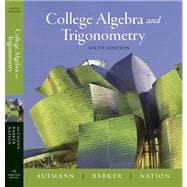
Note: Supplemental materials are not guaranteed with Rental or Used book purchases.
Purchase Benefits
What is included with this book?
| Preliminary Concepts | |
| The Real Number System | |
| Integer and Rational Number Exponents | |
| Polynomials | |
| Factoring | |
| Rational Expressions | |
| Complex Numbers | |
| Equations and Inequalities | |
| Linear and Absolute Value Equations | |
| Formulas and Applications | |
| Quadratic Equations | |
| Other Types of Equations | |
| Inequalities | |
| Variation and Applications | |
| Functions and Graphs | |
| A Two Dimensional Coordinate System and Graphs | |
| Introduction to Functions | |
| Linear Functions | |
| Quadratic Functions | |
| Properties of Graphs | |
| The Algebra of Functions | |
| Modeling Data Using Regression | |
| Polynomial and Rational Functions | |
| The Remainder Theorem and the Factor Theorem | |
| Polynomial Functions of Higher Degree | |
| Zeros of Polynomial Functions | |
| The Fundamental Theorem of Algebra | |
| Graphs of Rational Functions and Their Applications | |
| Exponential and Logarithmic Functions | |
| Inverse Functions | |
| Exponential Functions and Their Applications | |
| Logarithmic Functions and Their Applications | |
| Properties of Logarithms and Logarithmic Scales | |
| Exponential and Logarithmic Equations | |
| Exponential Growth and Decay | |
| Modeling Data with Exponential and Logarithmic Functions | |
| Trigonometric Functions | |
| Angles and Arcs | |
| Right Triangle Trigonometry | |
| Trigonometric Functions of Any Angle | |
| Trigonometric Functions of Real Numbers | |
| Graphs of the Sine and Cosine Functions | |
| Graphs of the Other Trigonometric Functions | |
| Graphing Techniques | |
| Harmonic Motion--An Application of the Sine and Cosine Functions | |
| Trigonometric Identities and Equations | |
| Verification of Trigonometric Identities | |
| Sum, Difference, and Cofunction Identities | |
| Double- and Half-Angle Identities | |
| Identities Involving the Sum of Trigonometric Functions | |
| Inverse Trigonometric Functions | |
| Trigonometric Equations | |
| Applications of Trigonometry | |
| The Law of Sines | |
| The Law of Cosines and Area | |
| Vectors | |
| Trigonometric Form of Complex Numbers | |
| De Moivre's Theorem | |
| Topics in Analytic Geometry | |
| Parabolas | |
| Ellipses | |
| Hyperbolas | |
| Rotation of Axes | |
| Introduction to Polar Coordinates | |
| Polar Equations of the Conics | |
| Parametric Equations | |
| Systems of Equations and Inequalities | |
| Systems of Linear Equations in Two Variables | |
| Systems of Linear Equations in More than Two Variables | |
| Nonlinear Systems of Equations | |
| Partial Fractions | |
| Inequalities in Two Variables and Systems of Inequalities | |
| Linear Programming | |
| Matrices | |
| Gaussian Elimination Method | |
| The Algebra of Matrices | |
| The Inverse of a Matrix | |
| Determinants | |
| Cramer's Rule | |
| Sequences, Series, and Probability | |
| Infinite Sequences and Summation Notation | |
| Arithmetic Sequences and Series | |
| Geometric Sequences and Series | |
| Mathematical Induction | |
| The Binomial Theorem | |
| Permutations and Combinations | |
| Introduction to Probability | |
| Table of Contents provided by Publisher. All Rights Reserved. |
The New copy of this book will include any supplemental materials advertised. Please check the title of the book to determine if it should include any access cards, study guides, lab manuals, CDs, etc.
The Used, Rental and eBook copies of this book are not guaranteed to include any supplemental materials. Typically, only the book itself is included. This is true even if the title states it includes any access cards, study guides, lab manuals, CDs, etc.